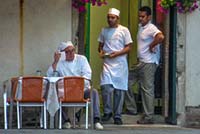Restaurants, bars, and gelaterie

Venice often gets a bad rap for its restaurants. While it's true that the city lacks the culinary credentials of a gastronomic mecca like Bologna or Lyon, you can eat decently in any city neighborhood.
The most expensive restaurants tend to be in the San Marco district or in the luxury
hotels along the waterfront east of the Doge's Palace.
If you want to save a
few euros and avoid the heaviest tourist crowds, head for outlying
neighborhoods, the island of Giudecca, or the
Lido di Venezia.
Suggestions and observations:
- Sample cichetti (tapas-like snacks) at a traditional osteria or wine bar.
- Try a Venetian specialty such as spaghetti nero di seppia (black spaghetti with cuttlefish ink).
- Order fish (but not if it's sold by market price and weight, unless you have money to burn.)
- If you're on a tight budget, order pizza (which is available at pizzerie and at many other restaurants).
- Sometimes, atmosphere is enough: You may not find the city's best cuisine at a candlelit restaurant on the Grand Canal, but you'll always remember the view of the Rialto Bridge.
- Forget about dining in restaurants where "only the Venetians go." Venice has been a tourist city for centuries.
- Don't assume that a restaurant with a multilingual menu is a tourist trap.
- Don't be suspicious if there's a small "coperto" (cover charge) on your bill. It's legitimate.
- In cafés and bars with waiters or waitresses, prices at tables are higher than at the bar.
- For advice on tipping, click here.
Drinks:
- Don't feel that you need to visit Harry's Bar and order a Bellini.
- Try a Venetian Spritz (a tall drink made with Prosecco sparkling white wine, fizzy water, and a dash of Aperol, Cinzano, Cynar, or Select bitters over ice with a slice of orange).
Gelato:
Venice has many gelaterie, and they can be addicting (especially in warm weather).
- See the Gelato Shops in Venice reviews at our parent site, Veniceforvisitors.com.
